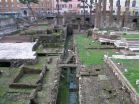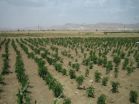(Press-News.org) A concrete structure of three meters wide and over two meters high, placed by order of Augustus (adoptive son and successor of Julius Caesar) to condemn the assassination of his father, has given the key to the scientists. This finding confirms that the General was stabbed right at the bottom of the Curia of Pompey while he was presiding, sitting on a chair, over a meeting of the Senate. Currently, the remains of this building are located in the archaeological area of Torre Argentina, right in the historic centre of the Roman capital.
Antonio Monterroso, CSIC researcher from the Institute of History of the Center for Humanities and Social Sciences (CCHS-CSIC), states: "We always knew that Julius Caesar was killed in the Curia of Pompey on March 15th 44 BC because the classical texts pass on so, but so far no material evidence of this fact, so often depicted in historicist painting and cinema, had been recovered".
Classical sources refer to the closure (years after the murder) of the Curia, a place that would become a chapel-memory. CSIC researcher explains: "We know for sure that the place where Julius Caesar presided over that session of the Senate, and where he fell stabbed, was closed with a rectangular structure organized under four walls delimiting a Roman concrete filling. However, we don't know if this closure also involved that the building ceased to be totally accessible".
Spaces of the assassination of Caesar
In Torre Argentina, in addition to the Curia of Pompey, researchers have started to study the remains of the Portico of the Hundred Columns (Hecatostylon). The aim is to identify what connecting links can be established between archaeology, art history, and cinema in these spaces of the death of Julius Caesar. Monterroso adds: "We also aim to better understand that sense of closure and dismal place described in classical texts".
The two buildings are part of the monumental complex (about 54.000 square meters) that Pompey the Great, one of the greatest military in the history of Rome, built in the capital to commemorate his military successes in the East around the year 55 BC.
Monterroso also states: "It is very attractive, in a civic and citizen sense, that thousands of people today take the bus and the tram right next to the place where Julius Caesar was stabbed 2056 years ago or even that they go to a theatre, since the main theatre of the capital is the Teatro Argentina, which is equally close".
INFORMATION:
The project, with duration of three years, relies on the approval and cooperation of the Sovraintendenza ai Beni Culturali of Rome City Council, on the financial support of the Plan Nacional 2008-2011 of the Spanish Ministry of Economy and Competitiveness, and on the backing of the CSIC Spanish School of History and Archaeology in Rome.
CSIC researchers find the exact spot where Julius Caesar was stabbed
They have found a concrete structure that the adoptive son of the General, killed in 44 BC, placed inside the Curia of Pompey to condemn his death
2012-10-10
ELSE PRESS RELEASES FROM THIS DATE:
Halving food losses would feed an additional billion people
2012-10-10
More efficient use of the food production chain and a decrease in the amount of food losses will dramatically help maintaining the planet's natural resources and improve people's lives. Researchers in Aalto University, Finland, have proved a valid estimation, for the first time, for how many people could be fed with reducing food losses. The world's population is an estimated seven billion people. An additional one billion can be fed from our current resources, if the food losses could be halved. This can be achieved if the lowest loss percentage achieved in any region ...
Return to Bremerhaven
2012-10-10
Polarstern is expected back from the Central Arctic expedition "IceArc" in Bremerhaven on 8 October 2012 after a good two months. 54 scientists and technicians from twelve different countries conducted research on the retreat of the sea ice and the consequences for the Arctic Ocean and its ecosystems over a period of two months in the High North. A number of new technologies were used for to film and photograph life in and below the ice down to a depth of 4400 metres. Since its departure from Tromsø (Norway) on 2 August 2012 Polarstern has travelled some 12,000 kilometres ...
Sitting on top of the world
2012-10-10
Do you have it in mind to go to a mountain top and study beetles that nobody else has ever seen? Well, there are two fewer such mountains available now that beetle species discovered on Mont Tohiea and Mont Mauru in the Society Islands have been named. James Liebherr, Curator of the Cornell University Insect Collection, has just described 14 species of predatory carabid beetle, also called ground beetles, as part of a U.S. National Science Foundation team that surveyed the insects and spiders of French Polynesia.
Liebherr described the species in two papers published ...
Study: Parenting more important than schools to academic achievement
2012-10-10
New research from North Carolina State University, Brigham Young University and the University of California, Irvine finds that parental involvement is a more significant factor in a child's academic performance than the qualities of the school itself.
"Our study shows that parents need to be aware of how important they are, and invest time in their children – checking homework, attending school events and letting kids know school is important," says Dr. Toby Parcel, a professor of sociology at NC State and co-author of a paper on the work. "That's where the payoff is."
The ...
Are liberal arts colleges disappearing?
2012-10-10
EAST LANSING, Mich. — Liberal arts colleges continue redefining their historical missions or flat-out disappearing – a trend that threatens to diminish America's renowned higher education system, argues a study co-authored by a Michigan State University scholar.
Of the 212 liberal arts colleges identified in a landmark 1990 study, only 130 remain in their traditional form – a 39 percent reduction, according to the new research.
While some liberal arts schools have closed or become part of larger universities due to financial problems, Roger Baldwin, MSU professor of ...
A tactile glove provides subtle guidance to objects in the vicinity
2012-10-10
Researchers at HIIT and Max Planck Institute for Informatics show how computer vision -based hand tracking and vibration feedback on the user's hand can be used to steer the user's hand toward an object of interest. A study shows an almost three-fold advantage in finding objects from complex visual scenes, such as library or supermarket shelves.
Finding an object from a complex real-world scene is a common yet time-consuming and frustrating chore. What makes this task complex is that humans' pattern recognition capability reduces to a serial one-by-one search when the ...
Angel investor market in steady recovery, UNH Center for Venture Research finds
2012-10-10
DURHAM, N.H. – The angel investor market in the first two quarters of 2012 showed signs of steady recovery since the correction in the second half of 2008 and the first half of 2009, with total investments at $9.2 billion, an increase of 3.1 percent over the same period in 2011, according to the Center for Venture Research at the University of New Hampshire.
A total of 27,280 entrepreneurial ventures received angel funding during the first half of 2012, a 3.7 percent increase from the same period in 2011, and the number of active investors in Q1 and Q2 2012 was 131,145 ...
Biologists describe details of new mechanism for molecular interactions
2012-10-10
UPTON, NY-Scientists at the U.S. Department of Energy's (DOE) Brookhaven National Laboratory, with collaborators from Harvard University, the University of Madrid, Princeton University, and the University of Zurich, have discovered a new mechanism that may alter principle understandings of molecular interactions within a cell's nucleus. The discovery illustrates how two proteins of the human adenovirus use DNA as an efficient form of transportation inside a newly synthesized virus particle. The proteins use what the scientists are calling a "molecular sled," which slides ...
From lectures to explosives detection: Laser pointer identifies dangerous chemicals in real-time
2012-10-10
WASHINGTON, Oct. 9, 2012—By using an ordinary green laser pointer, the kind commonly found in offices and college lecture halls, an Israeli research team has developed a new and highly portable Raman spectrometer that can detect extremely minute traces of hazardous chemicals in real time. The new sensor's compact design makes it an excellent candidate for rapid field deployment to disaster zones and areas with security concerns. The researchers will present their findings at Laser Science XXVIII—the American Physical Society Division of Laser Science's Annual Meeting—collocated ...
Satiation hormone could increase risk of diabetes, heart attack and breast cancer in women
2012-10-10
The findings have been presented in a study from Lund University in Sweden, published in the Journal of the American Medical Association.
"It was surprising to find such a clear link to the risk of type 2 diabetes and cardiovascular disease as well as to breast cancer. Obesity is a common risk factor for all three conditions, but the connection with neurotensin is not explained by obesity or other known risk factors", says Professor Olle Melander from the Department of Clinical Sciences at Lund University, who is also a consultant at Skåne University Hospital.
"This ...
LAST 30 PRESS RELEASES:
Making lighter work of calculating fluid and heat flow
Normalizing blood sugar can halve heart attack risk
Lowering blood sugar cuts heart attack risk in people with prediabetes
Study links genetic variants to risk of blinding eye disease in premature infants
Non-opioid ‘pain sponge’ therapy halts cartilage degeneration and relieves chronic pain
AI can pick up cultural values by mimicking how kids learn
China’s ecological redlines offer fast track to 30 x 30 global conservation goal
Invisible indoor threats: emerging household contaminants and their growing risks to human health
Adding antibody treatment to chemo boosts outcomes for children with rare cancer
Germline pathogenic variants among women without a history of breast cancer
Tanning beds triple melanoma risk, potentially causing broad DNA damage
Unique bond identified as key to viral infection speed
Indoor tanning makes youthful skin much older on a genetic level
Mouse model sheds new light on the causes and potential solutions to human GI problems linked to muscular dystrophy
The Journal of Nuclear Medicine ahead-of-print tip sheet: December 12, 2025
Smarter tools for peering into the microscopic world
Applications open for funding to conduct research in the Kinsey Institute archives
Global measure underestimates the severity of food insecurity
Child survivors of critical illness are missing out on timely follow up care
Risk-based vs annual breast cancer screening / the WISDOM randomized clinical trial
University of Toronto launches Electric Vehicle Innovation Ontario to accelerate advanced EV technologies and build Canada’s innovation advantage
Early relapse predicts poor outcomes in aggressive blood cancer
American College of Lifestyle Medicine applauds two CMS models aligned with lifestyle medicine practice and reimbursement
Clinical trial finds cannabis use not a barrier to quitting nicotine vaping
Supplemental nutrition assistance program policies and food insecurity
Switching immune cells to “night mode” could limit damage after a heart attack, study suggests
URI-based Global RIghts Project report spotlights continued troubling trends in worldwide inhumane treatment
Neutrophils are less aggressive at night, explaining why nighttime heart attacks cause less damage than daytime events
Menopausal hormone therapy may not pose breast cancer risk for women with BRCA mutations
Mobile health tool may improve quality of life for adolescent and young adult breast cancer survivors
[Press-News.org] CSIC researchers find the exact spot where Julius Caesar was stabbedThey have found a concrete structure that the adoptive son of the General, killed in 44 BC, placed inside the Curia of Pompey to condemn his death




